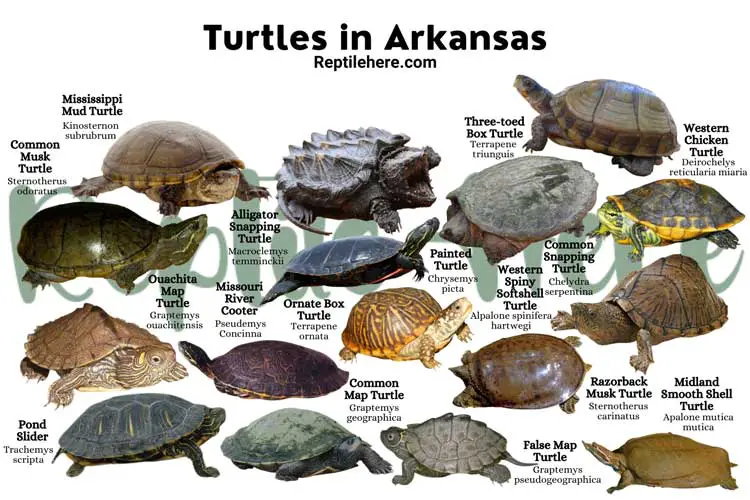Turtles in Arkansas – 16 Species That are Found Here
Arkansas, the land of diamonds, boasts up to 16 different species of turtles, including terrestrial and aquatic species.
It is home to species like snapping turtles (including the biggest of all—the alligator snapping turtle!), map turtles, mud and musk turtles, and softshell turtles.
What’s more, it is home to two terrestrial species of turtles, namely the ornate box turtle and three-toed box turtles.
In this article, we are going to discuss all these turtle species of Arkansas.
We will focus on basic information about each species like the physical appearance, size, lifespan, diet, habitat, conservation status, and more.
16 Types Of Turtles in Arkansas
Contents
1. Common Snapping Turtle
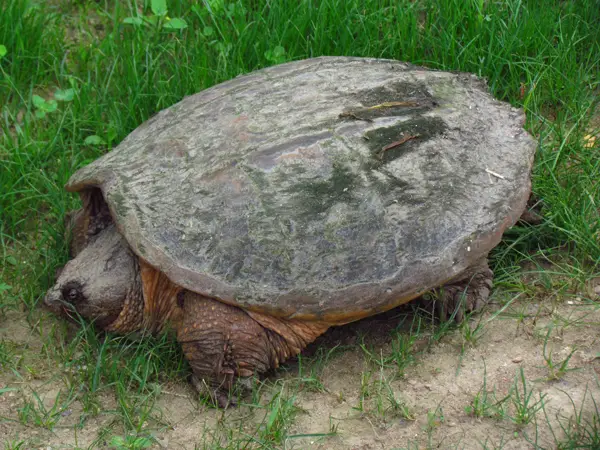
- Scientific name: Chelydra serpentina
- Common name: Snapping Turtle
- Family: Chelydridae
- Size: 8 to 18 1/2 inches
- Lifespan: 30 to 50 years (or more)
- Conservation status: Least Concern
Common snapping turtles are found widespread in Arkansas. An average adult is pretty large and has a shell length of 18½ inches long.
This species has a chunky head, a long tail, and large webbed feet. The shell color is black or olive and has no distinct pattern. These Arkansas snapping turtles are known for their powerful jaws—they’re so strong that these turtles eat other turtles!
You’ll find them in waterbodies with muddy bottoms. Examples include marshes, ponds, lakes, rivers, and even shallow streams. They generally prefer waters with aquatic vegetation in plenty and foods such as fish, frogs, birds, etc.
These Arkansas turtles generally show docile behavior but can get quite aggressive if taken out of water. The best way to calm it is to take it back to the waters, where it feels safe.
2. Alligator Snapping Turtle
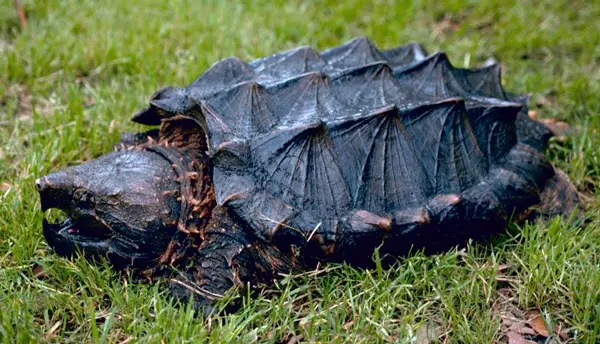
- Scientific name: Macroclemys temminckii
- Common name: Alligator snapping turtle, Snapping turtle
- Family: Chelydridae
- Size: 15 to 26 inches
- Lifespan: 80 to 120 years
- Conservation status: Vulnerable
The alligator snapping turtle is the largest freshwater turtle in Arkansas. This species is large than the common snapping turtle. An adult alligator snapping turtle weighs 15 to 20 inches long.
An alligator turtle is characterized by a long, tough shell with trigonal ridges that resemble the back of an alligator (hence the name alligator turtle). Shell coloring can be black, olive, or brown. Though some people believe that the green tips on the shell ridges are natural, they’re simply algae.
These alligator turtles also prefer living in deeper waters of rivers, canals, lakes, and swamps in Arkansas.
As omnivorous species, they hunt their prey (but not actively). They have a unique way of hunting where they lie at the bottom of the water body and open their mouth to show their pink work-like appendage to lure their prey. And when the prey gets close enough, the turtle ambushes it!
Another interesting fact about this turtle is its powerful jaws which can bite with a force of up to 1000lbs! This makes them extremely dangerous turtles and should NEVER be handled in the wild!
Mind you, they have injured even the most experienced herpetologists with their bites.
3. Common Map Turtle
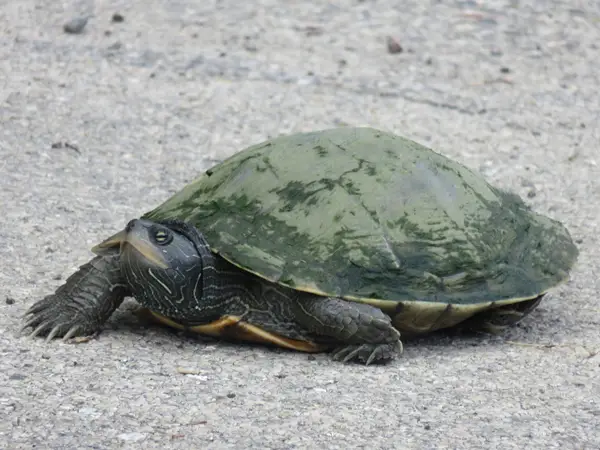
- Scientific name: Graptemys geographica
- Common name: Common Map Turtle
- Family: Emydidae
- Size: 3 to 10 inches
- Lifespan: 30 to 50 years
- Conservation status: Least Concern
The common map turtle is another species that inhabits Arkansas. To be more specie, this freshwater turtle resides in the rivers and lakes of Arkansas.
They prefer living in large waterbodies with debris. These offer the perfect spots for basking while the water bodies enable them to spend their hibernation periods in winter completely submerged.
Like other map turtles, this common map turtle gets its name from the map-like pattern on its shell. Its shell is typically darker and ranges from brown to black. The map pattern has a lighter coloration.
The common map turtle of Arkansas is mainly carnivorous and feeds on mollusks such as clams and snails. It will also eat crayfish and insects. And when animal matter gets scarce, it will feed on plant matter.
Note that it may be difficult to spot a common map turtle in the wild in Arkansas. Although active during the day, these turtles are quite timid and will quickly retreat to the waters at the slightest disturbance.
4. False Map Turtle
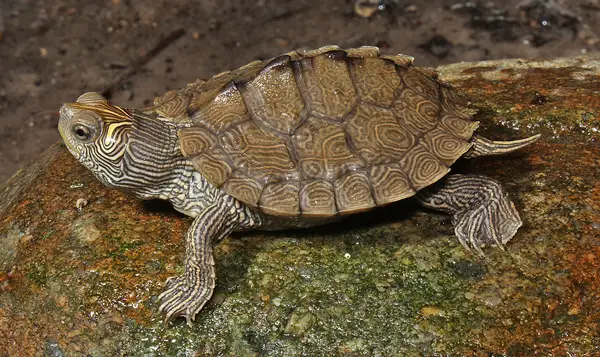
- Scientific name: Graptemys pseudogeographica kohni
- Common name: Mississippi Map Turtle, False Map Turtle
- Family: Emydidae
- Size: 3 to 10 inches
- Lifespan: 30 to 50 years
- Conservation status: Least Concern
The False map turtle is another turtle species found in Arkansas. This turtle’s preferred habitat in Arkansas includes rivers, streams, and oxbow lakes of the Missouri and Mississippi river systems.
It is an excellent swimmer and prefers moderate currents and deep waters.
Its upper shell coloring ranges from olive to dark brown, with light-colored lines on its limbs. It also features a line behind its eye that forms a backward “L” shape. The map pattern on its carapace tends to fade as the turtle ages.
Since this map turtle of Arkansas is omnivorous, it feeds on aquatic insects and animals as well as vegetation. It is fond of river snails and crustaceans. Don’t forget it has strong jaws and can give a nasty bite!
Like most of the other aquatic turtles of Arkansas, this map turtle spends most of its waking hours sunning.
The map turtle is quite shy and quietly and swiftly slides into the water at the slightest signs of disturbance. It likes spending most of its time in water and is most active in climate conditions of over 85 degrees Fahrenheit.
5. Ouachita Map Turtle
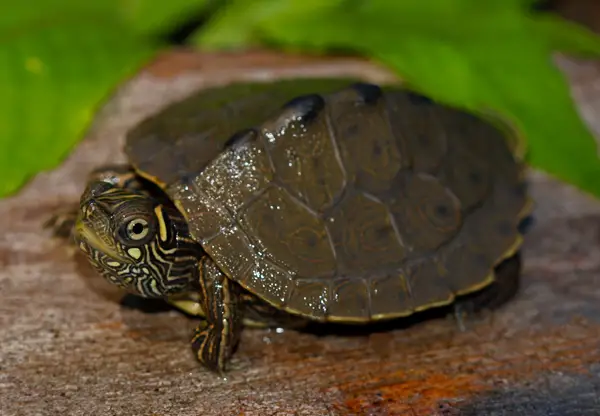
- Scientific name: Graptemys ouachitensis
- Common name: Ouachita Map Turtle
- Family: Emydidae
- Size: 3 to 5 inches (males), 8 to 10 inches (females)
- Lifespan: 30 to 50 years
- Conservation status: Least Concern
The Ouachita map turtle lives in the swift rivers and streams forming the Mississippi River and its tributaries in Arkansas.
It is regarded as one of the less popular map turtle species. The turtle makes an excellent choice of pet for many people since it’s easy to care for.
As for its name, this species is named after the river where it was discovered—Ouachita!
Ouachita turtle is medium to large in terms of size. The average adult female is 3-5 inches long while the male is 8 to 10 inches long. It features thin, yellowing lines that form a web on the turtle’s shell (similar to a contour elevation map).
Moreover, the turtle has brown to olive coloring, with a light spot under both eyes.
The easiest way to identify this Arkansas turtle species from other map turtle subspecies is by checking the dots on its face. They usually have 3 prominent spots—under the jawline, under the eye, and behind the eye.
Note that this turtle prefers living in stagnant or slow-moving waters, including ponds, lakes, and streams of Arkansas.
It also prefers waters with plenty of vegetation. This species is omnivorous and eats meat, insects, vegetables, fruits, aquatic vegetation, etc.
6. Missouri River Cooter
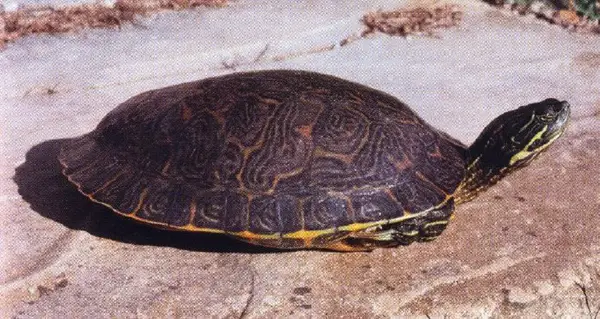
- Scientific name: Pseudemys Concinna
- Common name: Missouri River Cooter
- Family: Emydidae
- Size: 8 to 15 inches
- Lifespan: 20 to 40 years
- Conservation status: Least Concern
This river Cooter species also resides in Arkansas. Its shell is pretty similar to other native species and ranges from olive green to brown, and black. It has yellow lines down its limbs and head.
Yellow lines, alongside faint grey markings, can also be spotted along its shell.
The females are generally larger than the males and the males have a flatter shell.
The river Cooter prefers living in water streams in Arkansas, but it can also be found in lakes and ponds.
This subspecies of river Cooter in Arkansas is highly omnivorous and at the same time an opportunistic feeder that eats almost anything it can swallow. Its diet is made up of land plant matter, aquatic plants, and animals (both dead and alive).
Note that the turtle is also an enthusiastic hunter and has been observed going to land to forage worms, and insects, and then retreat to water to feast on its catch.
7. Pond Slider
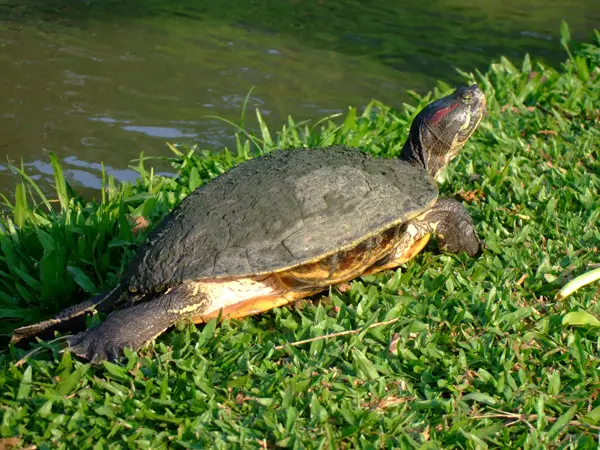
- Scientific name: Trachemys scripta
- Common name: Pond slider
- Family: Emydidae
- Size: 7 to 12 inches
- Lifespan: 30 to 40 years
- Conservation status: Least Concern
Pond sliders is a term used to refer to 3 sub-species of turtles namely yellow belly sliders, red-eared sliders, and Cumberland sliders.
For all these 3 subspecies, the males are usually smaller than the females and have thicker tails.
Baby pond sliders are characterized by green shells and a yell-green or dark green skin color. But this color fades as they age. Males, in particular, tend to get darker. Their legs, neck, and head feature yellow marks and stripes alongside this dark appearance.
Red-eared sliders are often confused with painted turtles due to red markings at the jawline plus brightly colored stripes. However, their carapace is more rounded and helmet-like compared to those of painted turtles. Sliders are also bigger than painted turtles in captivity.
Pond sliders in Arkansas prefer living in slow-moving waters such as rivers, ponds, lakes, and swamps. They also prefer habitats with muddy bottoms.
As for the diet, pond sliders are omnivorous but they’re more into eating vegetation in their adult age. The young ones are more carnivorous and will eat meat more.
People commonly purchase this turtle species in Arkansas as a pet but later on release it into the world when it becomes difficult to take care of or gets too large. But this isn’t a good practice as it can cause pressure on the natural ecosystem.
Also read: Turtles in Ohio
8. Painted Turtle
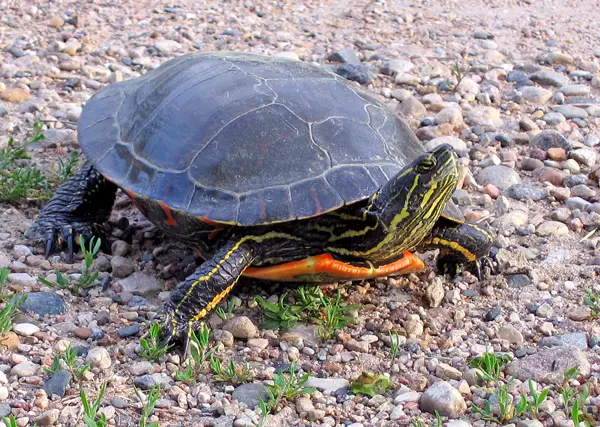
- Scientific name: Chrysemys picta
- Common name: Painted Turtle
- Family: Emydidae
- Size: 4 to 6 inches
- Lifespan: 30 to 50 years
- Conservation status: Least Concern
The painted turtle is one of the most recognizable turtle species in Arkansas, thanks to its beautiful and unique coloring. The bright reds and yellow-green markings on its shell, head, and limbs are no doubt a beauty to behold!
This species has up to 4 subspecies (Eastern, Western, Midland, and Southern species). And although they may slightly differ in appearance, they also have similar behavior.
The painted turtle species in Arkansas has been observed to live near water bodies with minimal movements. Examples include marshes, ponds, slow-moving streams with sandy/muddy bottoms, small lakes, etc.
They also prefer areas with aquatic plants in plenty as they make their primary food source in the wild.
One interesting fact about these Arkansas turtles is their ability to hold their breath for up to 30 hours when inside temperate water. Moreover, they’re capable of standing dominant in freezing cold waters for up to 4 months.
Unfortunately, it’s not easy to establish the population of these turtles in Arkansas. This is because most people who pet them end up releasing them back into the wild. This contributes to an ever-expanding range plus unstable reproduction rates for these turtles.
9. Razorback Musk Turtle
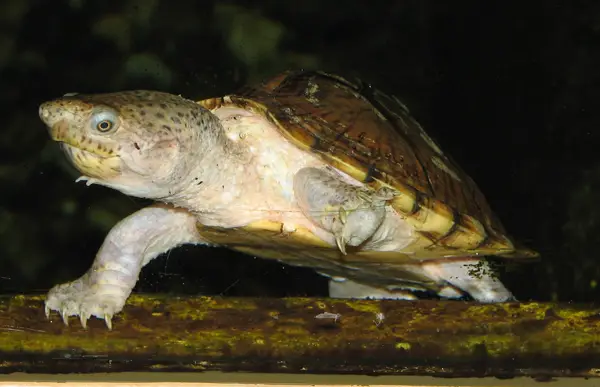
- Scientific name: Sternotherus carinatus
- Common name: Musk turtle, stinkpot
- Family: Kinosternidae
- Size: 5 to 6 inches
- Lifespan: 40 to 50 years
- Conservation status: Least Concern
The Arkansas razor-backed must turtle is identified by the keels on its back. In other words, its carapace is shaped like a tent that comes to a point along its spine and then slopes down on its sides.
Just like the other must turtles, this species is also pretty small and the average adult hits 5-6 inches in length. Their shell color ranges from light grey to olive, brown, and black. Skin color can be olive or dark brown, though the exact color differs from individual to individual.
These Arkansas turtles usually have long necks and large heads which usually have bright colors and turn gray with dark spots as they age.
This razor-back musk turtle prefers living in water almost entirely and will only leave the waters to bask or when it’s time to lay eggs. The species live in deep waters of oxbow lakes and river swamps. They also prefer living in slow-current large streams.
Diet-wise, the Arkansas razor-back musk turtle is mainly carnivorous and is fond of mollusks, snails, and fish.
10. Common Musk Turtle
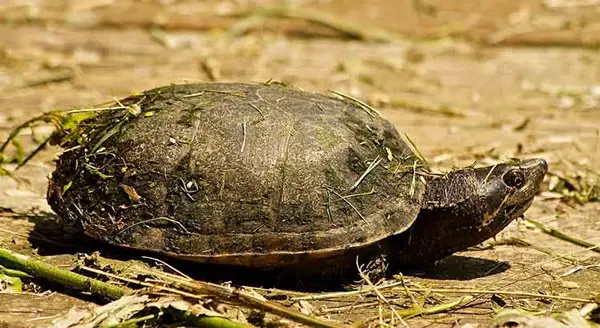
- Scientific name: Sternotherus odoratus
- Common name: Common Musk Turtle, Musk Turtle, Stinkpot
- Family: Kinosternidae
- Size: 2 to 4.5 inches
- Lifespan: 30 to 50 years
- Conservation status: Least Concern
The Common Musk Turtle is another aquatic turtle found in Arkansas’s slow-moving and sluggish streams as well as still water bodies.
The turtle usually prefers areas with dark crevices, where it can easily hide. It also prefers lots of plant matter to burrow in and hide.
An average adult eastern musk turtle is quite small (2 to 4.5 inches long). It has a pretty plain appearance with highly consistent colors. Both the shell and skin usually share the same color and can range from dark brown to black.
The turtle shell has one unique feature—a ridge traversing its entire shell length. Besides, it has another distinctive feature: two light-colored stripes on its head.
Common musk turtles in Arkansas are mainly herbivorous and will eat small aquatic or semi-aquatic animals, carrion, and aquatic vegetation. They will also feed on any other vegetation on land.
When it feels threatened, this turtle species emits a foul odor (a musky odor, hence its name). This scent can be detected in water or on land. It can also easily waft through the air to its predators.
Also, these Arkansas turtles are good at climbing trees! This great capability enables them to go high up tree branches to find a safe resting place and avoid predators.
11. Mississippi Mud Turtle

- Scientific name: Kinosternon subrubrum
- Common name: Eastern Mud Turtle, Mud Turtle
- Family: Kinosternidae
- Size: 3 to 5 inches
- Lifespan: 50 years
- Conservation status: Least Concern
The Mississippi Mud turtle in Arkansas is found in shallow waters including ditches, marshes, wet meadows, and swamps.
This smaller aquatic turtle species is characterized by a smooth and unmarked shell. Yes, it has an incredible plain look, with its upper shell lacking any patterns. The carapace color ranges from dark yellow to black.
The lower side of the shell is also pretty plain, though it usually appears lighter on the upper part. The key distinction of this mud turtle is the stripes on its head which can be white or yellow in color.
One particular feature that sets this turtle apart from others and makes it easily identifiable is the hinges on its lower shell which form a “K” shape when viewed from the sides.
Just as its name suggests, this turtle lives in water bodies with a soft muddy, or sandy bottom. Thus, they can be found in marshes, swamps, and rivers in Arkansas.
Since the Arkansas eastern mud turtle is omnivorous, it eats meat, fish, snails, insects, and aquatic vegetation as well as plant matter on land.
Unlike other turtles, eastern mud turtles do not hibernate in the cold winter months. Instead, it does the opposite—it becomes dormant in the hot months of summer (this is known as aestivation).
12. Western Spiny Softshell Turtle
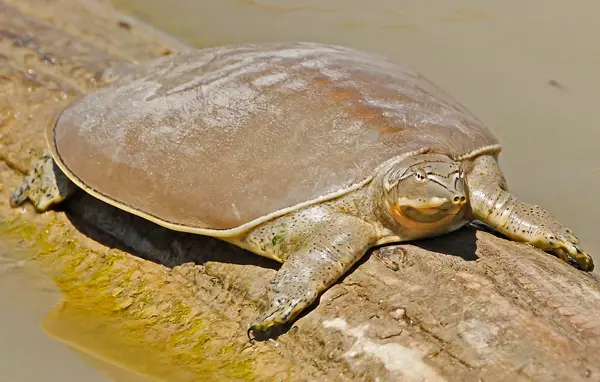
- Scientific name: Alpalone spinifera hartwegi
- Common name: Spiny Softshell Turtle
- Family: Trionychidae
- Size: 5 to 9 inches (males), 12 to 20 inches (females)
- Lifespan: 30 to 70 years
- Conservation status: Least Concern
The Western Spiny softshell turtle is a medium-to-large freshwater species that lives in Arkansas’ lakes, streams, and rivers with muddy or sandy bottoms and little or no vegetation.
Female spiny softshell turtles are usually larger than males. And unlike other turtles, this species has a flexible, leather-like carapace that’s extremely rounded and flattened. The shell color can be olive grey or yellow-brown. Just like other softshell turtles, this species also has a snorkel-like snout.
The young ones feature well-defined round spots that are easily visible on the shell (though these spots become invisible as they transition to adulthood).
Spiny softshell turtles in Arkansas tend to eat anything they find in the waters including crayfish, insects, small fish, and so on. They hunt by burying themselves in the mud or sand while keeping their head uncovered to grab food as it swims by.
These turtles are also able to breathe underwater by taking in oxygen through their throat skin. This is a useful adaptation given that they don’t spend a lot of time out of water.
Other adaptations of these turtles include webbed feed, long claws, and extremely flat shells that enable them to quickly swim away from predators and burry in the muddy bottom of the waters they reside in.
13. Midland Smooth Shell Turtle
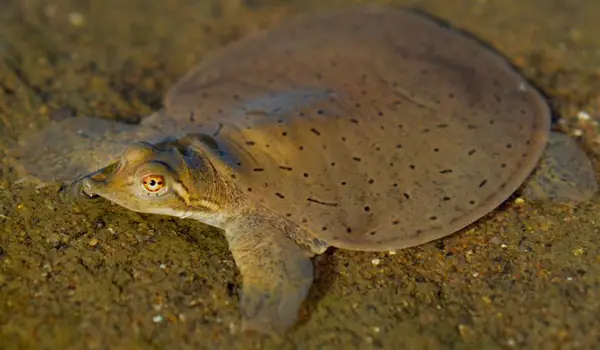
- Scientific name: Apalone mutica mutica
- Common name: Midland Smooth Shell
- Family: Trionychidae
- Size: 6 to 13 inches
- Lifespan: 40 to 60 years
- Conservation status: Least Concern
The midland smooth softshell turtle boasts its position as the fastest turtle on land in Arkansas! Though most people believe these turtles are slow-moving, they must be quick to enable them to outrun their predators given that their soft shells don’t offer much protection.
Shell color of this turtle species ranges from olive to dark brown. The upper part of its shell features dark markings (with female markings appearing in a blotchier pattern than the males’)
The shell of these turtles also appears rounder and flatter, just like other softshell species.
Note that Gulf Coast smooth turtle (Apalone calvata) is the closes relative of this Midland smooth softshell turtle. The main difference existing between these two species is size, with the Gulf coast turtle reaching a maximum of 12 inches long.
Also, the Gulf coast species has no lines on its face while the midland smooth softshell turtle does.
These turtles like inhabiting waterbodies like rivers and streams in Arkansas that provide an abundance of mud or sand at the bottom. They can also be found in stagnant waterbodies.
Midland smooth softshell turtles are omnivorous and their diet revolves around aquatic vegetation and insects. However, they have been observed to like meat more than plant matter and will mainly eat snails, insects, and fish.
14. Western Chicken Turtle
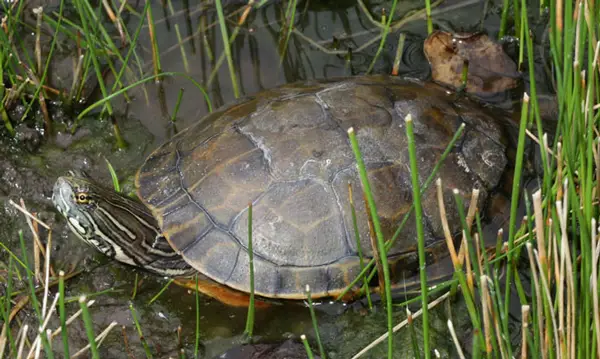
- Scientific name: Deirochelys reticularia miaria
- Common name: Western Chicken Turtle
- Family: Emydidae
- Size: 5 to 10 inches
- Lifespan: 15 to 30 years
- Conservation status: Least Concern
Western chicken turtle is a subspecies of chicken turtle species, native to the Southern US, including Arkansas state.
This species of turtle is regarded as the most social turtle species you’ll find in Arkansas! They’re known to bask or swim in groups and rarely live or travel alone.
The easiest way to observe them is when they’re basking, since most of their activities, including reproduction and feeding, happen underwater.
Chicken turtle shells are egg-shaped (oval) compared to other turtles and are black or dark brown in color. They also feature subtle yellow patterns. The lower side of the shell is usually yellow and the skin is dark and covered with yellow stripes.
Chicken turtles in Arkansas prefer living in still water areas such as ponds, marshes, and ditches in Arkansas. However, it is also easy to spot them on land when they’re foraging for food or basking in the sun.
For the diet part, chicken turtles are omnivorous and like eating meat, fish, snails, insects, aquatic vegetation, and land plant matter such as fruits and veggies.
An interesting fact: Chicken turtles are so named because of their meat taste, which was a popular delicacy back in the 1970s!
15. Ornate Box Turtle
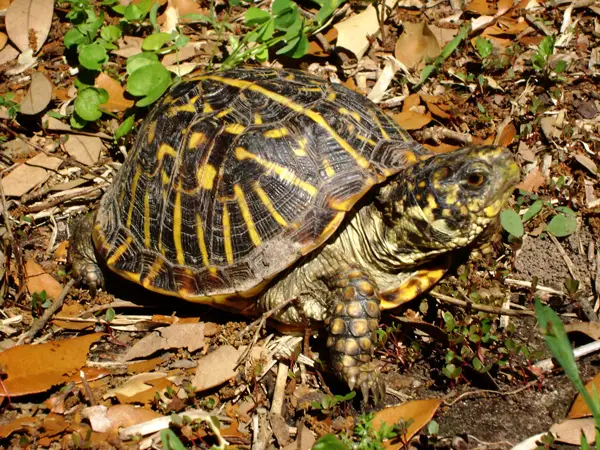
- Scientific name: Terrapene ornata
- Common name: Ornate Box Turtle
- Family: Emydidae
- Size: 5 to 7 inches
- Lifespan: 40 to 60 years
- Conservation status: Near Threatened
Ornate box turtles are present in Arkansas and are recognized by the beautiful pattern on their carapace. This eye-pleasing pattern is sometimes referred to as a starburst pattern.
Their skin is grey and may feature yellow or white spots. Male heads occasionally feature a green color.
Though there exists a little distinction between the males and females of these Arkansas box turtles, the males are generally smaller than the females.
During hot weather, this turtle requires water to help regulate its body temperature.
The Arkansas species of turtle are known to hibernate in burrows during cold weather. They’re also capable of surviving in frozen soils for several days.
Being omnivorous in nature, and opportunistic feeders, these turtles will gladly eat anything available to them in their habitat or what’s abundant in a given season.
They have been observed eating fruits, vegetables, grasshoppers, and various other insects.
Also, these box turtles are pretty shy and don’t like being handled excessively. As such, you may want to avoid approaching them suddenly while in the wild in Arkansas.
16. Three-toed Box Turtle
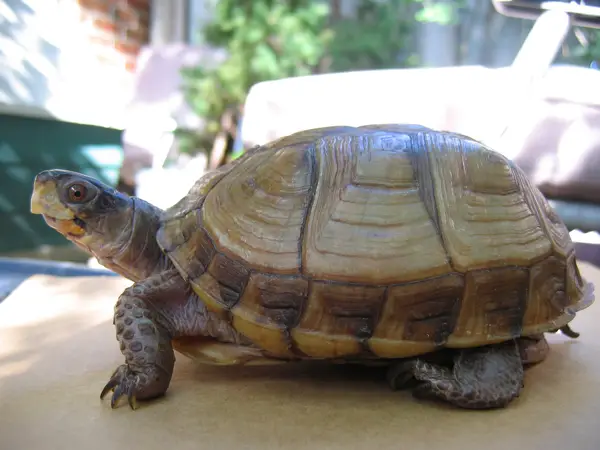
- Scientific name: Terrapene triunguis
- Common name:
- Family: Emydidae
- Size: 4.5 to 5 inches
- Lifespan: 50 to 100 years
- Conservation status: Vulnerable
The three-toed box turtles inhabit the thickets, prairies, and woodlands of Arkansas. They’re easily identifiable by the 3 toes on their hind limbs, unlike the usual 4 toes on other box turtle species.
They have a uniform olive to brown shell color, sometimes with light spots or streaks. Bright yellow or orange spots are also occasionally spotted on the turtle species’ head and leg.
A mature three-toed box turtle has an average size of 4.5 to 5 inches.
They are unlike other box turtles in that they’re the only species that will remain healthy if you have them in indoor enclosures.
Being omnivorous in nature, these Arkansas turtles are known to eat snails, insects, earthworms, slugs, mushrooms, strawberries, and green-leafed vegetation. They have also been spotted eating quail eggs.
Related: Turtles In Idaho
Conclusion
This article has fully discussed all the species in Arkansas and basic information about each of them like their physical appearance, size, lifespan, diet, habitat, and conservation status.
As you can see, Arkansas is home to a wide variety of species of turtles. The various turtles residing in this state include snapping turtles, map turtles, mud and musk turtles, softshell turtles, and box turtles.
The state of Arkansas is also home to Alligator snapping turtle, the largest known freshwater turtle!


